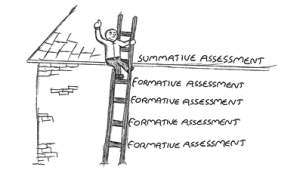This morning I was checking out the question and answer forum on the TeachingChannel and I came across a question about the different types of assessments. Given that a new school has kicked off, I think it’s a perfect time to explore the differences between formative and summative assessments and how they align to the UDL framework.
 To begin, any assessment that informs instruction is super valuable, and these are often administered before teaching a unit of instruction. Sometimes these assessments are called diagnostic assessments and other times they are called formative assessments, but the purpose is the same. When these assessments are given, teachers use the data/results to inform instruction, as they become aware of students’ strengths and areas of weakness. I don’t recommend using the results of formative assessments in a student’s grade, as in theory, the material has not yet been taught and therefore a student should be not penalized for underperforming. Imagine being graded on something you’ve never been taught. It would probably be pretty frustrating!
To begin, any assessment that informs instruction is super valuable, and these are often administered before teaching a unit of instruction. Sometimes these assessments are called diagnostic assessments and other times they are called formative assessments, but the purpose is the same. When these assessments are given, teachers use the data/results to inform instruction, as they become aware of students’ strengths and areas of weakness. I don’t recommend using the results of formative assessments in a student’s grade, as in theory, the material has not yet been taught and therefore a student should be not penalized for underperforming. Imagine being graded on something you’ve never been taught. It would probably be pretty frustrating!
After the formative assessment, teachers plan standards-based instruction to allow all students to access the curriculum – the rich data from the formatives allow teachers to set a scope and sequence for curriculum and instruction. While teachers and students are engaged in a unit of study, informal formative assessments are given to check in to see where students are at, to determine if certain concepts need to be explored in more depth and also to determine if students are engaged in the process of learning. I find it valuable to ask students to access teacher instruction informally at this time as well, as they can offer valuable feedback about their own learning.
Once students have learned material, through access to a universally designed curriculum, teachers can give summative assessments, which measure a student’s growth since the formative assessment. If students have not yet learned the materials, Tier II intervention may be necessary to insure that all students have the opportunity to learn important background information before moving on to more complex topics.
On a final note, none of these assessments have to be “traditional” in any way. Some teachers may choose multiple choice objective tests, but both formative and summative assessment can take many different shapes. As long as the product allows teachers to assess student learning in response to specific standards, the assessment is doing its job.



